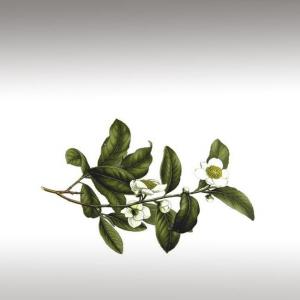
CAMELLIA OIL (CAMELLIA SINENSIS) - BASE OILS

BASE / GENERAL DATA
Information submited: March 11, 2014 Modified: April 3, 2018 By: OperaDreamhouse
Camellia Sinensis (chá huā Yóu) is the species of plant whose leaves and leaf buds are used to produce the popular beverage tea. White tea, Yellow tea, Green tea, Oolong, Pu-erh tea and Black tea are all harvested from this species, but are processed differently to attain different levels of oxidation. Kukicha (Twig tea) is also harvested from Camellia Sinensis, but uses twigs and stems rather than leaves. Common names include Tea Plant, Tea Shrub, and Tea Tree.
Camellia Sinensis is native to East, South and Southeast Asia, but it is today cultivated across the world in tropical and subtropical regions. It is an evergreen shrub or small tree that is usually trimmed to below 2 m when cultivated for its leaves. It has a strong taproot. The flowers are with yellow-white.
The seeds of Camellia Sinensis can be pressed to yield Tea oil, a sweetish seasoning and cooking oil that should not be confused with Tea Tree oil (Melaleuca Alternifolia), an essential oil that is used for medical and cosmetic purposes, and originates from the leaves of a different plant.
Tea Seed oil (Camellia) is an edible, pale amber-green fixed oil with a sweet, herbal aroma. It is cold-pressed mainly from the seeds of Camellia Sinensis.
Camellia oil has several synonyms such as White Camellia oil, Camellia Sasanqua oil, Tea Seed oil, Camellia Seed oil, Tsubaki, Cha Hua. The oil is derived by cold pressing from Camellia plant seeds.
Camellia flowers are native to Japan and North China a long time ago, where they blossom in November and stay fresh even under the snow. The flowers can be white, pink or red color. Within six months the seeds are ripened and used for expressing the purest natural oil with precious qualities for health, skin and hair care.
Chemical structure:
Camellia Seeds contain between 40 - 50% of nutritive oil that is low in saturated fat. Approximately 85% of the fatty acid composition contained in Camellia oil is in the form of monounsaturated oleic acid. Camellia oil is also a rich source of other omega-3, omega-6 and omega-9 fatty acids plus Vitamin E andpolyphenols. It has a shelf life of at least 18 months when stored in a cool dry place, away from direct sunlight. The recommended usage is 2 - 10% in most formulations.
Research by Preventive Medicine Sun Yat-Sen University, Institute found Camellia Extract used for bathing and washing powder.
Camellia oil is commonly used to clean and protect the blades of cutting instruments.
Camellia Sinensis is native to East, South and Southeast Asia, but it is today cultivated across the world in tropical and subtropical regions. It is an evergreen shrub or small tree that is usually trimmed to below 2 m when cultivated for its leaves. It has a strong taproot. The flowers are with yellow-white.
The seeds of Camellia Sinensis can be pressed to yield Tea oil, a sweetish seasoning and cooking oil that should not be confused with Tea Tree oil (Melaleuca Alternifolia), an essential oil that is used for medical and cosmetic purposes, and originates from the leaves of a different plant.
Tea Seed oil (Camellia) is an edible, pale amber-green fixed oil with a sweet, herbal aroma. It is cold-pressed mainly from the seeds of Camellia Sinensis.
Camellia oil has several synonyms such as White Camellia oil, Camellia Sasanqua oil, Tea Seed oil, Camellia Seed oil, Tsubaki, Cha Hua. The oil is derived by cold pressing from Camellia plant seeds.
Camellia flowers are native to Japan and North China a long time ago, where they blossom in November and stay fresh even under the snow. The flowers can be white, pink or red color. Within six months the seeds are ripened and used for expressing the purest natural oil with precious qualities for health, skin and hair care.
Chemical structure:
Camellia Seeds contain between 40 - 50% of nutritive oil that is low in saturated fat. Approximately 85% of the fatty acid composition contained in Camellia oil is in the form of monounsaturated oleic acid. Camellia oil is also a rich source of other omega-3, omega-6 and omega-9 fatty acids plus Vitamin E andpolyphenols. It has a shelf life of at least 18 months when stored in a cool dry place, away from direct sunlight. The recommended usage is 2 - 10% in most formulations.
Research by Preventive Medicine Sun Yat-Sen University, Institute found Camellia Extract used for bathing and washing powder.
Camellia oil is commonly used to clean and protect the blades of cutting instruments.

SPIRITUAL PRACTISES DATA

MEDICINE / HEALTH DATA
Information submited: March 11, 2014 Modified: April 3, 2018 By: OperaDreamhouse
Used for centuries in Japan and China, but discovered in the West
relatively recently Camellia oil is true elixir for health and beauty.
Camellia Seed oil is great to use during pregnancy. Camellia oil is ideal for face massage due to its fast absorbency and light, velvety consistency, safe and gentle as baby massage oil too.
Oil has been shown to reduce bad cholesterol.
Tea Seed oil is also used as an ingredient in the Chinese medicated oil Po Sum On.
Camellia Seed oil is great to use during pregnancy. Camellia oil is ideal for face massage due to its fast absorbency and light, velvety consistency, safe and gentle as baby massage oil too.
Oil has been shown to reduce bad cholesterol.
Tea Seed oil is also used as an ingredient in the Chinese medicated oil Po Sum On.

BEAUTY / COSMETICS DATA
Information submited: March 11, 2014 Modified: April 3, 2018 By: OperaDreamhouse
Suitable for dry, normal, mature, oily, allergy prone skin types.
Camellia oil has been used for centuries for beauty of skin and hair in China and Japan. Geishas of Kyoto used to moisturize their skin and hair with Tsubaki oil.
Samurais wiped their swards with Camellia oil to protect it from rusting and corrosion, which is an early evidence of its excellent antioxidant qualities.
Camellia oil is currently a popular ingredient for face creams particularly dry and mature skin, after-sun lotions, shampoos and conditioners for dry and damaged hair. This natural, moisturizing oil has a light but lively scent that has been recognized for centuries for its restorative and rejuvenating effects on skin.
Camellia oil has outstanding moisture and emollient properties and it is one of the lightest and fast absorbent plant oils. It penetrates skin as fast as water, leaving it supple and hydrated. Th oil contains mono-saturated essential fatty acids and very high in oleic acid (Omega-9 fatty acid). Camellia oil contains Vitamins A, B, and E and one of the most precious constituent for skin such as phytosqualene. Squalene is a natural component of human sebum. With age the deficiency of Squalene results in dry skin, premature aging and wrinkles.
Camellia oil protects skin from harmful UV and environmental damage, forming a thin shield against strong sun rays and change of temperatures. It also known to protect from age spots, freckles and excessive pigmentation. It is safe to use around eyes to prevent from crowfeet and mimic lines. In fact for pregnant women Camellia oil is beneficial in preventing and diminishing stretch marks.
Camellia oil can also be used to hydrate dry and damaged hair. It's softens hair and makes it more manageable, treats dry scalp and itchiness, forms a barrier against environmental pollutants.
Camellia oil is a nutrient and antioxidant-rich body skin moisturizer and softener (especially in areas such as elbows, legs, knees and heels). It heals minor acne scars.
Camellia oil is very god for nail care.
Camellia oil has been used for centuries for beauty of skin and hair in China and Japan. Geishas of Kyoto used to moisturize their skin and hair with Tsubaki oil.
Samurais wiped their swards with Camellia oil to protect it from rusting and corrosion, which is an early evidence of its excellent antioxidant qualities.
Camellia oil is currently a popular ingredient for face creams particularly dry and mature skin, after-sun lotions, shampoos and conditioners for dry and damaged hair. This natural, moisturizing oil has a light but lively scent that has been recognized for centuries for its restorative and rejuvenating effects on skin.
Camellia oil has outstanding moisture and emollient properties and it is one of the lightest and fast absorbent plant oils. It penetrates skin as fast as water, leaving it supple and hydrated. Th oil contains mono-saturated essential fatty acids and very high in oleic acid (Omega-9 fatty acid). Camellia oil contains Vitamins A, B, and E and one of the most precious constituent for skin such as phytosqualene. Squalene is a natural component of human sebum. With age the deficiency of Squalene results in dry skin, premature aging and wrinkles.
Camellia oil protects skin from harmful UV and environmental damage, forming a thin shield against strong sun rays and change of temperatures. It also known to protect from age spots, freckles and excessive pigmentation. It is safe to use around eyes to prevent from crowfeet and mimic lines. In fact for pregnant women Camellia oil is beneficial in preventing and diminishing stretch marks.
Camellia oil can also be used to hydrate dry and damaged hair. It's softens hair and makes it more manageable, treats dry scalp and itchiness, forms a barrier against environmental pollutants.
Camellia oil is a nutrient and antioxidant-rich body skin moisturizer and softener (especially in areas such as elbows, legs, knees and heels). It heals minor acne scars.
Camellia oil is very god for nail care.

FOOD / COOKING DATA
Information submited: March 11, 2014 Modified: April 3, 2018 By: OperaDreamhouse
Camellia oil is a high quality cooking oil that remains stable at high temperatures. It possesses a high smoke point of 485F (251C).
Relatively little-known outside East Asia, it is the most important cooking oil for hundreds of millions of people, particularly in southern China. Camellia oil resembles Olive oil and Grape Seed oil in its excellent storage qualities and low content of saturated fat.
Camellia seed oil is used in salad dressings, dips, marinades and sauces, for stir frying and frying and in margarine production.
Relatively little-known outside East Asia, it is the most important cooking oil for hundreds of millions of people, particularly in southern China. Camellia oil resembles Olive oil and Grape Seed oil in its excellent storage qualities and low content of saturated fat.
Camellia seed oil is used in salad dressings, dips, marinades and sauces, for stir frying and frying and in margarine production.
COMMENTS
No comments.


